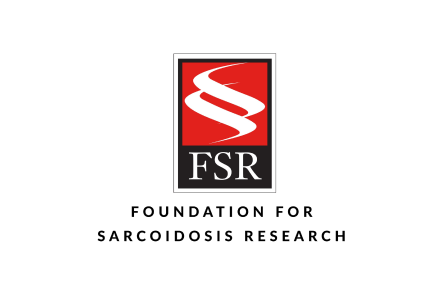Foundation for Sarcoidosis Research (FSR)
Cycle 2
Sarcoidosis is an inflammatory disease characterized by the formation of granulomas—tiny clumps of inflammatory cells—in one or more organs of the body. When the immune system goes into overdrive and too many of these clumps form, they can interfere with an organ’s structure and function. When left unchecked, chronic inflammation can lead to fibrosis, which is the permanent scarring of organ tissue.
Last updated May 2024
Clinical
Disease Class
Rare cardiac diseases
Rare diseases due to toxic effects
Rare disorder without a determined diagnosis after full investigation
Rare endocrine diseases
Rare gastroenterological diseases
Rare hepatic diseases
Rare immunological diseases
Rare neurological diseases
Rare ophthalmic diseases
Rare renal diseases
Rare respiratory diseases
Rare skin diseases
Rare systemic and rheumatological diseases
Rare transplant-related diseases
Body Systems
Cardiovascular / Circulatory
Digestive
Endocrine
Hematopoietic / Lymphatic / Immune
Integumentary / Exocrine
Muscular / Skeletal
Nervous / Sensory
Renal / Urinary / Excretory
Reproductive
Respiratory
Organs
Adrenal glands
Bladder
Brain
Connective tissue / joints
Esophagus
Eyes
Gallbladder
Heart
Intestines
Kidneys
Liver
Lungs
Lymph fluid, nodes, ducts, vessels
Mouth / teeth
Muscles
Nose
Ovaries
Pancreas
Skin
Spinal cord
Spleen
Stomach
Testes
Throat
Genes
HLA-DRB1
Type of Inheritance
Not specified / unknown
Disease Mechanism(s)
Aberrant immune response
Autoimmune
Autoinflammatory disorder
Age of Onset
Adolescence (12-17)
Adulthood (age 18-64)
Early childhood (age 1+-5)
Elderly (age 65+)
Middle childhood (6-11)
Incidence
51-100
Prevalence
10000+
Populations and/or ancestry with higher prevalence
African Amerians 2-3x higher prevelance , Veterans 5 x higher prevelance, Japanese (cardiac only), Scandanavian countries
Symptoms / Phenotypes
balance problems
breathing difficulties
cardiac abnormalities
cognitive impairment / confusion / brain fog
edema
fainting / syncope
fatigue
gastrointestinal disorders
headaches / migraines
joint pain / arthralgia
pain, chest
skin redness and/or swelling
subcutaneous nodules
swollen lymph nodes
vertigo
vision problems
vitiligo
vomiting / nausea
weight loss
Biomarkers
Diagnostic
· serum and bronchoalveolar lavage biomarkers, imaging (chest x-ray, MRI, FDG-PET, CT), biopsy, ACE levels tools and cell signaling pathways. Fluor-18-deoxyglucose positron emission tomography and high-resolution computed tomography
Monitoring
· PROs, FDG-PET, CT, MRI, ACE Levelserum amyloid A (SAA), soluble interleukin-2 receptor (sIL-2R), lysozyme, angiotensin-converting enzyme (ACE), the glycoprotein KL-6, Pfts,levels of neopterin, elastase, chitotriosidase, glycoprotein Krebs von den Lungen, Th17 cell count, reduced quantity of TNF-α in peripheral blood or bronchoalveolar lavage fluidn
Prognostic
· FDG-PET inflammation level, ACE, levels of neopterin, elastase, sIL-2R, chitotriosidase, glycoprotein Krebs von den Lungen, Th17 cell count, reduced quantity of TNF-α in peripheral blood or bronchoalveolar lavage fluid
Existing Therapies
Alternative treatments (eg. nutritional supplements)
· anti-inflammatory diet, exercise, meditation/mindfulness
Drugs approved for the symptoms
Drugs used off-label
· Methotrexate, Azothiprine, Mycophenolate Mofetil, Adalimumab,Infliximab, IVIG, JAK-Inhibitors
Organizational & Research
Cell Lines
B lymphocytes
Beta cells
CD34 cells
Fibroblasts
Lymphoblasts
Macrophages
Myoblasts
Plasma
Primary human skeletal muscle cells
Primary lymphatic endothelial cells
Type 2 pneumocytes
Cell Lines, location
Not specified
Cell Lines, share
Unknown
Disease Model
Mouse
Disease Model, location
Hull York Medical School
Medical University of Vienna
The Ohio State University (OSU)
University of Freiburg
Yale School of Medicine
Disease Model, share
No
Clinical Trial Role
Data analysis
Data sharing
Focus group
Funding
Meeting with regulators
Outcome measures, development
Recruitment and outreach, patients
Recruitment and outreach, trial sites/physicians
Results dissemination, publication
Study material design, review (not protocol)
Study protocol design, review
Travel coordination
Biobank
None
Center of Excellence
Cedars-Sinai
Cleveland Clinic
Corewell Health
Emory University
Henry Ford Health
Hospital for Special Surgery
Inova Health
Jefferson Health
Lahey Hospital
MedStar Hospital
Mt. Sinai
National Jewish Health
Northwestern Memorial Hospital
Oklahoma Medical Research Foundation (OMRF)
Rutgers University
SUNY Upstate
Stanford University
Tampa General Hospital
Temple University Hospital
UTHealth Houston (The University of Texas Health Science Center at Houston)
University of Alabama
University of California, Los Angeles (UCLA)
University of Florida
University of Illinois Chicago
University of Kentucky
University of Minnesota
University of Mississippi
University of North Carolina (UNC)
University of Oklahoma
University of Texas Southwestern Medical Center (UTSW)
University of Virginia (UVA)
Vanderbilt University
Virginia Commonwealth University
Washington University
West Virginia University Medicine
Yale University Hospital
Registry
Yes, we have a registry that we created
Data Collected, Registry
Longitudinal natural history data
Medication usage
Patient contact info
Patient-reported data
Data Entered by, Registry
Patients
Platform, Registry
Invitae Patient Insights Network
Natural History Study
No, we do not have a natural history study, but we plan to create or collaborate on one
FDA Patient Listening Session
Yes
FDA Patient-Focused Drug Development (PFDD) Program
We have taken formal steps to schedule a meeting
ICD Codes
Yes, we have an ICD-10 code specific to our exact disease
Yes, we have an ICD-11 code specific to our exact disease
Diagnostic Guidelines
Yes
Clinical/Treatment Guidelines
Yes
Organizational Roles
Director of Operations/Director of Development
Executive Director
Patient Engagement Manager/Director
Registry Coordinator
Science Advisory Board Policies
Yes, willing to share SAB policies
Research Network Policies
Has CRN and willing to share policies
Research Roadmap
We don't have a Research Roadmap
International Chapters
None
International Partners
Asia
Europe
North America
South America
